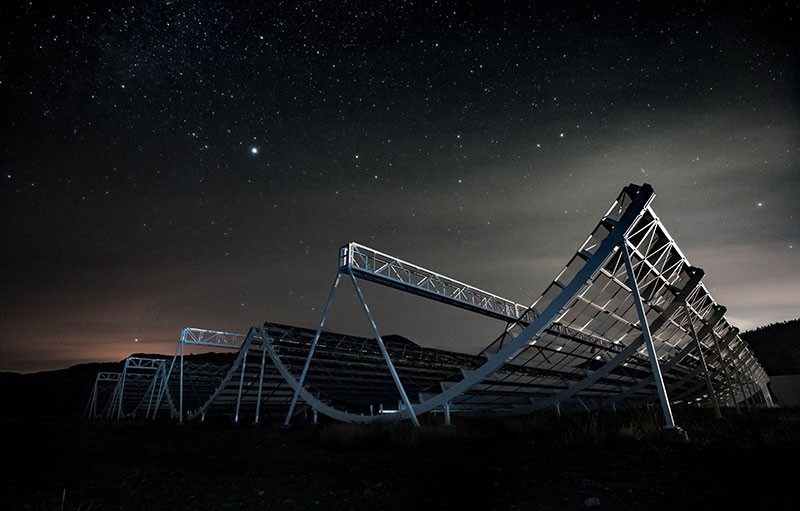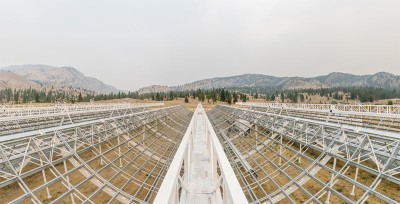A radio telescope in Canada has detected 535 fast radio bursts, quadrupling the known tally of these brief, highly energetic phenomena in one go. The long-awaited results show that these enigmatic events come in two distinct types — most bursts are one-off events, with a minority repeating periodically and lasting at least ten times longer on average.
The findings1 strongly suggest that fast radio bursts could be the result of at least two distinct astrophysical phenomena. “I think this really just nails it that there is a difference,” says study co-author Kiyoshi Masui, an astrophysicist at the Massachusetts Institute of Technology in Cambridge.
The overnight jump in the available data has put the radio astronomy community into a tizzy. “I woke up this morning and all my Slack channels were full of people talking about the papers,” says Laura Spitler, an astrophysicist at the Max Planck Institute for Radio Astronomy in Bonn, Germany, who co-discovered the first repeating burst2 in 2016 using the now-collapsed Arecibo telescope in Puerto Rico.
The Canadian Hydrogen Intensity Mapping Experiment (CHIME) collected the events in its first year of operation, between 2018 and 2019. The team announced its results during a virtual meeting of the American Astronomical Society on 9 June, and posted four preprints on the online repository arXiv.
Repeaters and one-offs
Located near Penticton in British Columbia, CHIME is a telescope with no moving parts. It comprises four half-pipe antennas, each 100 metres long. At any given time, it observes one narrow strip of the sky above it. But as Earth rotates, the telescope scans the sky, and digital processing chips collect its signals to form an image.
CHIME was initially conceived to map the distribution of matter in the Universe, but a complex kit of extra electronics was added in its design so that it could pick up fast radio bursts as well. Spitler recalls that many workers in the field had been sceptical about the telescope’s potential for detecting the bursts, but the latest announcement has vindicated it. “They’re actually meeting their prediction,” Spitler says. “It’s extremely impressive.”
Although the jury is still out on what causes fast radio bursts, the CHIME results seem to cement the idea that there are at least two distinct types. Sixty-one of the 535 detected were ‘repeaters’ — they came from 18 sources that have been seen emitting bursts multiple times. The two groups of bursts differ in duration, with one-off events being much shorter. Repeaters also emit on a much narrower band of radio frequencies than do one-off bursts.
“It’s by far the most compelling evidence that there are two populations,” says Spitler.
Until now, the evidence for this was not strong: some astronomers argued that non-repeating bursts could just have been repeaters that had not been observed for long enough to see them burst again. “It doesn’t mean the phenomenon is wildly different, but it could be,” Masui adds.
Fast radio bursts tend to be detected over one second or more. But this duration is misleadingly long: as signals travel across millions of light years of space, intergalactic matter tends to smear radio waves across the spectrum, a phenomenon known as dispersion. As a result, lower-frequency waves can arrive at Earth with a delay of several seconds compared with higher-frequency ones. Researchers have calculated that, at the source, the emission of a radio burst typically lasts only milliseconds. During that time, the source of a burst can emit 500 million times more energy than the Sun over a comparable amount of time.
The extent of this dispersion of wavelengths provides a rough indication of how far the waves had to travel. So far, all bursts have been shown to originate in other galaxies, except for one event that occurred in the Milky Way.
The CHIME team reported that the bursts’ sources seemed to be evenly spread across the sky. Only a handful could be traced to any particular galaxy.
Origin theories
In recent years, researchers have monitored some the regions of the sky that produced bursts in the past, and in some cases have seen them re-occur with regular periodicity. The ‘repeater’ discovered by Spitler and her collaborators in 2016, for example, has cycles of activity lasting a day or so — emitting several bursts per hour — and repeating every 160 days.
This regular repetition offers some clues to what might be causing the bursts. One possible explanation, Spitler says, is that repeaters could occur when a highly magnetized neutron star circles around an ordinary star in an elongated orbit. As the neutron star periodically gets closer to its companion, bursts could result from its magnetic field scattering the highly energetic stellar wind.
Non-repeaters, on the other hand, could be the result of cataclysmic events, such as the collisions of neutron stars, or magnetic storms in young neutron stars called magnetars. The Milky Way event was linked to a known magnetar. But the magnetar theory has been cast into doubt by the finding, reported last month, of a burst from a ‘globular cluster’ in the galaxy M813. Globular clusters are dense collections of very old stars, and are considered unlikely to host magnetars.
The first discovery of a fast radio burst in 2007 came as a shock to researchers, and for many years only a few were known, Masui recalls. Theorists came up with a plethora of possible explanations, and the running joke was that the theories outnumbered the actual events. Now CHIME has reversed that trend, he says: “I don’t think theorists will catch up with us.” And this first catalogue of bursts is only the beginning: since those results were collected, the team has continued to detect many more fast radio bursts, and will publish them for years to come.
Mysterious fast radio bursts come in two distinct flavours - Nature.com
Read More



No comments:
Post a Comment